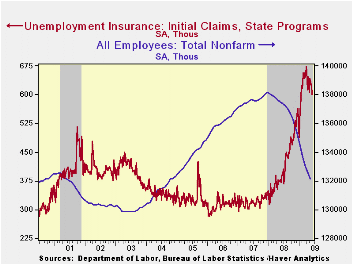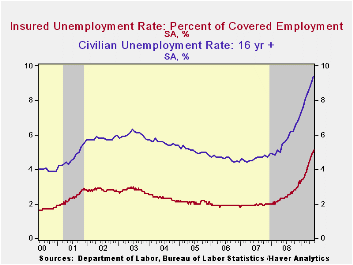 Global| Jun 11 2009
Global| Jun 11 2009U.S. Initial Jobless Insurance Claims Fall To Their Lowest Since January
by:Tom Moeller
|in:Economy in Brief
Summary
At the margin, the labor market continues to show signs of firming ... but just a bit. The latest indication is that last week, initial claims for unemployment insurance fell a sharp 24,000 to 601,000 from a little revised 625,000 [...]

At the margin, the labor market continues to show signs of firming ... but just a bit. The latest indication is that last week, initial claims for unemployment insurance fell a sharp 24,000 to 601,000 from a little revised 625,000 during the prior two weeks. Initial claims are down from their March peak of 674,000. Moreover, the four-week average of claims, which smoothes out some of the volatility in the weekly numbers, fell to 621,750 which was its lowest level since since mid-February. Still, the level remained up by two-thirds from the year ago level. The Consensus expectation was for 615,000 claims last week.
The Labor Department indicated that the largest increases in initial claims for the week ending May 30 were in Connecticut (+816), Louisiana (+809), Tennessee (+672), Arizona (+618), and Nebraska (+576), while the largest decreases were in Florida (-6,655), Illinois (-4,496), Michigan (-4,385), California (-3,551), and Texas (-2,886).
Despite the indication of fewer jobs lost, new job creation remains under pressure. Continuing claims for unemployment insurance, which provide an indication of workers' ability to find employment, rose to another record high of 6,816,000, more than twice the year ago level. Further indicating that the job market remains weak, the four-week average of continuing claims also rose to another record of 6,750,500. The series dates back to 1966.
Further indicating the labor market's softness was that the insured unemployment rate held at 5.1% for the second consecutive week. That level was more than double last May and the highest level since 1983. During the last ten years there has been a 93% correlation between the level of the insured unemployment rate and the overall rate of unemployment published by the Bureau of Labor Statistics.Clearly, the latest weekly figure understates labor market distress in some states.
The highest insured unemployment rates in the week ending May 23 were in Michigan (7.2 percent), Oregon (6.9), Puerto Rico (6.4), Nevada (6.3), Pennsylvania (6.2), Wisconsin (5.8), Arkansas (5.4), North Carolina (5.4), Illinois (5.3), and South Carolina (5.3).
The unemployment insurance claims data is available in Haver's WEEKLY database and the state data is in the REGIONW database.
| Unemployment Insurance (000s) | 06/06/09 | 05/30/09 | 05/23/09 | Y/Y | 2008 | 2007 | 2006 |
|---|---|---|---|---|---|---|---|
| Initial Claims | 601 | 625 | 625 | 54.9% | 420 | 321 | 313 |
| Continuing Claims | -- | 6,816 | 6,757 | 117.6% | 3,342 | 2,552 | 2,459 |
Tom Moeller
AuthorMore in Author Profile »Prior to joining Haver Analytics in 2000, Mr. Moeller worked as the Economist at Chancellor Capital Management from 1985 to 1999. There, he developed comprehensive economic forecasts and interpreted economic data for equity and fixed income portfolio managers. Also at Chancellor, Mr. Moeller worked as an equity analyst and was responsible for researching and rating companies in the economically sensitive automobile and housing industries for investment in Chancellor’s equity portfolio. Prior to joining Chancellor, Mr. Moeller was an Economist at Citibank from 1979 to 1984. He also analyzed pricing behavior in the metals industry for the Council on Wage and Price Stability in Washington, D.C. In 1999, Mr. Moeller received the award for most accurate forecast from the Forecasters' Club of New York. From 1990 to 1992 he was President of the New York Association for Business Economists. Mr. Moeller earned an M.B.A. in Finance from Fordham University, where he graduated in 1987. He holds a Bachelor of Arts in Economics from George Washington University.






